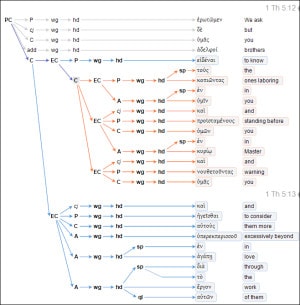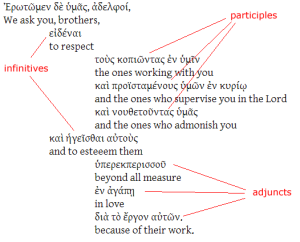Awhile back, I blogged on how syntax graphs aren’t just helpful when it comes to searching. They can be very helpful when reading through the text as well. And they can help one organize thoughts and approach when teaching or preaching on a passage.
A case in point is First Thessalonians 5.12-13. I dug into this passage in preparation for a home group Bible study. The OpenText.org Syntactically Analyzed Greek New Testament: Clause Analysis helped me to organize my thoughts on how this passage is structured, therefore it helped in thinking how this passage should be understood.
When looking at the graph for 1Th 5.12-13, one sees that the primary clause has two complements. One is simply “you”, the other is an extended portion that contains most of vv. 12-13. We’re interested in it all, but for structural purposes we’re interested in the complement. At this point, it helps to review what a complement is in the OpenText.org annotation:
Complement: A Complement (C) of a clause is a word group or the word groups that completes the predicator of the clause. The categories of direct and indirect object from traditional grammar are among those classified as complements. A clause may have no complement or many complements. With relation to the process of the clause, the complement(s) are those components of the clause that answer the question who? or what? is affected by the process.
Porter, S., O’Donnell, M. B., Reed, J. T., Tan, R., & OpenText.org. (2006; 2006). The OpenText.org Syntactically Analyzed Greek New Testament Glossary. Logos Research Systems, Inc.
One thing I do when working through a passage is very simple. I copy the Greek text from the NA27 as text and paste it into Notepad. (yes, Notepad). Then I insert returns and tabs to organize or block the text as I best see fit. I usually do this with structure in mind, so that means I’m paying attention to main verbs and using returns/tabs to indent stuff. I don’t do this in any systematic way, I just want to get an idea of the flow of the text. After I block it, then I do my own interlinear translation (again, in Notepad).
When I looked at the graph for 1Th 5.12-13, the extended complement jumped out at me. Note that the complement consists of two embedded clauses (both are embedded clauses because their verbs are infinitive). The first embedded clause has a further complement that has three embedded clauses (participles). The second embedded clause has one complement (them) but three adjuncts. This immediately informed me how I should make my own outline:
Let’s put this all together. First, we need to realize the role of the complement. As mentioned above, it
The second complement has two infinitive verbs, “to respect/know” and “to esteem/consider”. Thus the request of Paul here has two parts, to respect and to esteem. Each of these parts has more information we can garner from the graph.
The first part, respect, has another embedded complement. Remember, the complement helps answer the “who” or “what” question. In this case, the complement answers the “who” question. Paul is asking the Thessalonians to respect those working among them, those who supervise/administer them (overseers/elders?), and those who admonish or warn them. I’ll leave it as an exercise to the reader to determine if these are multiple groups of people or if these are three ways of referring to the same group of people.
The second part, esteem/consider, has a complement (“them”, referring to the ones described in the first part) and then has three adjuncts. Let’s recall how an adjunct is defined by the OpenText.org annotation:
Adjunct: An Adjunct (A) of a clause is a word group or the word groups that modify the predicator, providing an indication of the circumstances associated with the process. Common adjuncts are prepositional and adverbial phrases (adverbs) and also embedded adverbial clauses. With relation to the process of the clause, adjuncts provide answers to questions of the type where?, when?, why? and how?.
Porter, S., O’Donnell, M. B., Reed, J. T., Tan, R., & OpenText.org. (2006; 2006). The OpenText.org Syntactically Analyzed Greek New Testament Glossary. Logos Research Systems, Inc.
The
Syntax graphs can help us approach a passage taking the underlying syntax into account. Focusing only on words means we are considering vocabulary (and we need to do this) but when we take the higher level of syntax into account and think about how all of these words and these groups of words relate to each other, we end up with a better and more cohesive understanding of the passage itself. Words by themselves are puzzle pieces; syntax helps us in assembling the puzzle into something recognizable.
Using the syntax graphs in this passage, we’ve isolated the main verb and examined how the main verb is “completed” (the complements). We’ve examined one of the complements to better understand what Paul was asking the Thessalonians. Paul’s request was twofold: respect and esteem. Based on the syntax, each of these two parts has further information that helps in answering the original question. If I was teaching or preaching this, I’d probably have two main points in the outline (the infinitives); each of those main points would have three sub points (complements one set of three, adjuncts the other set of three).
Of course, if you’re like me, you’d use that as a basis to start your work and would likely end up with something a little different than you would if you strictly adhered to the OpenText.org reading of this passage. But that’s OK. Syntax should be one thing that informs your process of exegesis; your lesson/sermon/whatever should be the outcome of that process. Perhaps after you consider syntax, you have other information (vocab/word studies, genre, rhetoric, textual variants, other grammatical features, historical interpretations, etc.) that point you in another direction. This is all just fine. Again, the lesson/sermon is the result of your study.
Syntax simply helps inform that result. This is my primary use of the syntax graphs. Sure, they’re helpful for noticing phenomenon and in constructing searches to isolate other instances of that phenomenon. And that sort of thing is helpful. But I use the graphs much more as I simply read the text, to help me understand how the current passage is structured and therefore help me in my interpretation of it.






